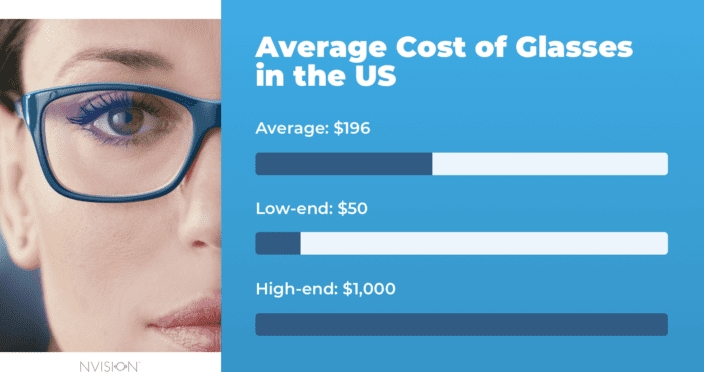How Much Should You Spend on Glasses?
Home / Everything About Glasses /
Last Updated:
Wearing glasses is necessary when you have certain vision deficiencies. They allow you to see clearly from a variety of distances. With so many glasses on the market, it can feel overwhelming when you are trying to find the perfect pair.
The first thing to do is evaluate both expensive glasses and cheap glasses. Compare and contrast the pros and cons of each pair.
Looking at the different price ranges helps you to establish your budget. Consider the features you want with your glasses to assess the right price range for you.
After you gather all this information, you can determine how much you need to spend on a pair of glasses that will fit your vision needs and personal preferences.

Average Price Ranges for Glasses
In the U.S., the cost of eyeglasses ranges greatly, from approximately $50 to over $1,000 for a single pair. The average cost is $196.
You also have to consider the average price for eye examinations in the U.S. You will need an eye exam before your doctor can write a prescription for eyeglasses. The following are U.S. averages:
- Initial eye exam with an eye doctor: $200
- Refractive vision test: $46
- Established patient eye exam: $128
Depending on where you live in the U.S., these costs can be considerably higher. If you have vision insurance, they may cover some of the costs for you.
If you have a pre-existing eye condition, you may need more than just a basic eye examination before getting a prescription for eyeglasses. You also need to take into account the costs associated with this.
How Much Should You Spend on Glasses?

You will need to create a budget to determine how much you can afford for your glasses. If you have vision insurance, they may cover at least part of the cost of one pair of eyeglasses every year. If you want to add any additional features, like anti-reflective coating, these might not be covered. Your insurance company may also only cover glasses in a specific price range.
Since the average price for eyeglasses is $196, you might want to plan to spend at least this much. This gives you a starting point when you are creating a budget. When working on your budget, make sure that you also take into consideration things like cloths to clean your lenses, eyeglass cleaning solution, a case to protect them, and the cost of your eye examination.
The right pair of glasses should be comfortable and the right prescription. This ensures that you can wear them throughout the day and get the vision enhancement you need.
You deserve clear vision. We can help.
With 135+ locations and over 2.5 million procedures performed, our board-certified eye surgeons deliver results you can trust.
Your journey to better vision starts here.
References
- Are Anti-Reflective Coatings Worth the Cost? Verywell Health.
- Scratch Resistant Lenses. Space Foundation.
- What Are Polarized Lenses? Healthline.
- How Much Do Eyeglasses Cost? Cost Helper.
This content is for informational purposes only. It may have been reviewed by a licensed physician, but is not intended to serve as a substitute for professional medical advice. Always consult your healthcare provider with any health concerns. For more, read our Privacy Policy and Editorial Policy.
